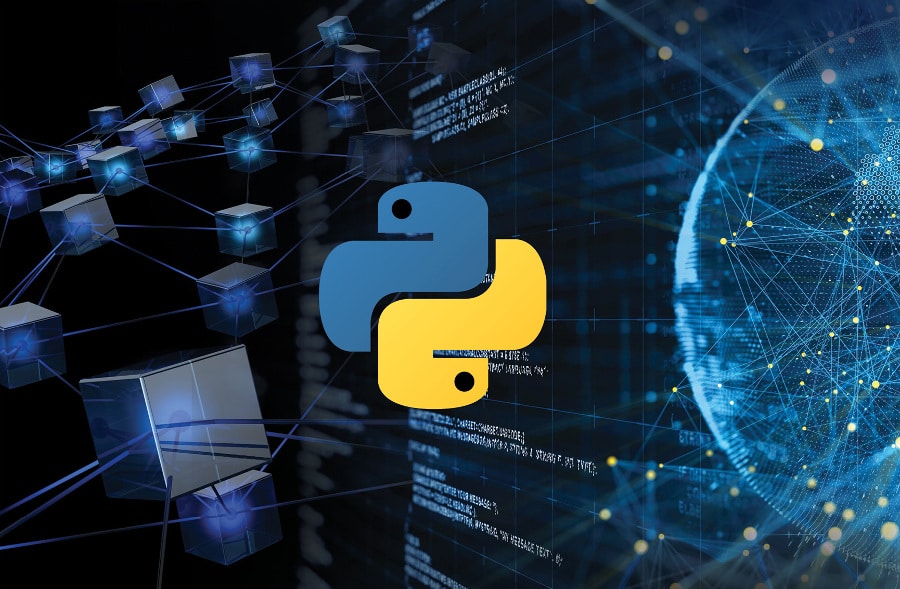By ATS Staff - June 10th, 2025
Blockchain Python Programming Software Development
The example below includes a basic blockchain structure with blocks containing an index, timestamp, data, previous hash, and a proof-of-work mechanism for mining. The code is designed to be beginner-friendly while demonstrating core blockchain concepts like immutability and hashing.
import hashlib
import time
import json
class Block:
def __init__(self, index, timestamp, data, previous_hash, nonce=0):
self.index = index
self.timestamp = timestamp
self.data = data
self.previous_hash = previous_hash
self.nonce = nonce
self.hash = self.calculate_hash()
def calculate_hash(self):
block_string = json.dumps({
"index": self.index,
"timestamp": self.timestamp,
"data": self.data,
"previous_hash": self.previous_hash,
"nonce": self.nonce
}, sort_keys=True).encode()
return hashlib.sha256(block_string).hexdigest()
class Blockchain:
def __init__(self, difficulty=4):
self.chain = []
self.difficulty = difficulty # Number of leading zeros required in hash
self.create_genesis_block()
def create_genesis_block(self):
genesis_block = Block(0, time.time(), "Genesis Block", "0")
self.mine_block(genesis_block)
self.chain.append(genesis_block)
def get_latest_block(self):
return self.chain[-1]
def add_block(self, data):
new_block = Block(
index=len(self.chain),
timestamp=time.time(),
data=data,
previous_hash=self.get_latest_block().hash
)
self.mine_block(new_block)
self.chain.append(new_block)
def mine_block(self, block):
target = "0" * self.difficulty
while block.hash[:self.difficulty] != target:
block.nonce += 1
block.hash = block.calculate_hash()
print(f"Block mined! Nonce: {block.nonce}, Hash: {block.hash}")
def is_chain_valid(self):
for i in range(1, len(self.chain)):
current_block = self.chain[i]
previous_block = self.chain[i-1]
# Verify current block's hash
if current_block.hash != current_block.calculate_hash():
print(f"Invalid hash in block {i}")
return False
# Verify previous block's hash
if current_block.previous_hash != previous_block.hash:
print(f"Chain broken at block {i}")
return False
# Verify proof of work
if current_block.hash[:self.difficulty] != "0" * self.difficulty:
print(f"Invalid proof of work in block {i}")
return False
return True
# Example usage
if __name__ == "__main__":
my_blockchain = Blockchain(difficulty=4)
print("Adding Block 1...")
my_blockchain.add_block({"transaction": "Alice pays Bob 10 BTC"})
print("\nAdding Block 2...")
my_blockchain.add_block({"transaction": "Bob pays Charlie 5 BTC"})
print("\nBlockchain valid?", my_blockchain.is_chain_valid())
# Print the blockchain
for block in my_blockchain.chain:
print(f"\nBlock #{block.index}")
print(f"Timestamp: {block.timestamp}")
print(f"Data: {block.data}")
print(f"Previous Hash: {block.previous_hash}")
print(f"Hash: {block.hash}")
print(f"Nonce: {block.nonce}")
# Test tampering with the blockchain
print("\nTampering with Block 1...")
my_blockchain.chain[1].data = {"transaction": "Alice pays Bob 100 BTC"}
print("Blockchain valid after tampering?", my_blockchain.is_chain_valid())
How It Works
- Block Class: Represents a single block in the chain, containing:
- Index: Position in the blockchain.
- Timestamp: When the block was created.
- Data: Transaction or other information (e.g., "Alice pays Bob 10 BTC").
- Previous Hash: Links to the previous block’s hash for immutability.
- Nonce: Used in proof-of-work to find a valid hash.
- Hash: A SHA-256 hash of the block’s contents.
- Blockchain Class: Manages the chain of blocks:
- Initializes with a genesis block (first block).
- Adds new blocks with data and mines them using proof-of-work.
- Validates the chain by checking hashes and proof-of-work.
- Proof-of-Work: Simulates mining by requiring the block’s hash to start with a set number of zeros (controlled by
difficulty). The nonce is incremented until a valid hash is found. - Validation: Ensures the chain’s integrity by verifying:
- Each block’s hash is correct.
- Each block’s previous hash matches the prior block’s hash.
- Each block meets the proof-of-work requirement.
Running the Code
- Save the code in a file (e.g.,
blockchain.py). - Run it using Python:
python blockchain.py. - The program creates a blockchain, adds two sample blocks, prints the chain, and tests tampering to demonstrate immutability.
Notes
- This is a simplified blockchain for educational purposes. Real-world blockchains (e.g., Bitcoin) include additional features like cryptographic signatures, decentralized networks, and consensus mechanisms beyond proof-of-work.
- The difficulty level (
difficulty=4) can be increased for more mining effort, but this will slow down block creation. - The code uses SHA-256 for hashing, a standard in blockchain technology.
Popular Categories
Agile 2 Android 2 Artificial Intelligence 50 Blockchain 2 Cloud Storage 3 Code Editors 2 Computer Languages 12 Cybersecurity 8 Data Science 15 Database 7 Digital Marketing 3 Ecommerce 3 Email Server 2 Finance 2 Google 6 HTML-CSS 2 Industries 6 Infrastructure 3 iOS 3 Javascript 5 Latest Technologies 42 Linux 5 LLMs 11 Machine Learning 32 Mobile 3 MySQL 3 Operating Systems 3 PHP 2 Project Management 3 Python Programming 26 SEO - AEO 5 Software Development 46 Software Testing 3 Web Server 7 Work Ethics 2